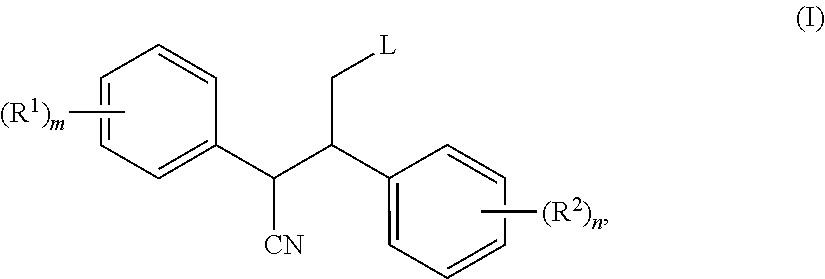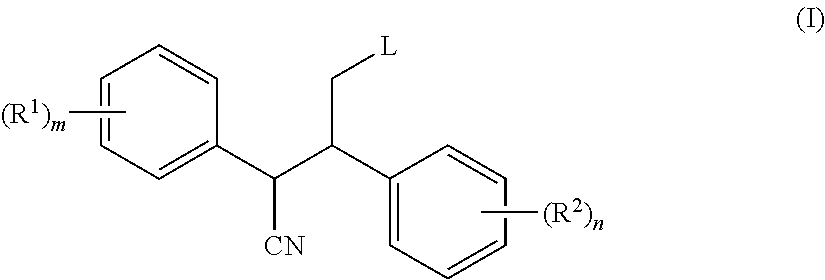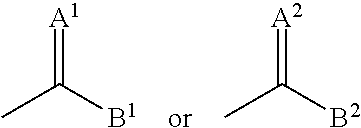2,3-diphenyl-valeronitrile derivatives, method for the production thereof and use thereof as herbicides and plant growth regulators
a technology of valeronitrile and diphenylvaleronitrile, which is applied in the direction of biocide, organic chemistry, chemistry apparatus and processes, etc., can solve the problems of unsatisfactory, toxicologically unfavourable profile, low selectivity of useful plants in crops, etc., and achieves good activity for harmful plants and high effectiveness
- Summary
- Abstract
- Description
- Claims
- Application Information
AI Technical Summary
Benefits of technology
Problems solved by technology
Method used
Image
Examples
example a1
Preparation of an erythro / threo diastereomer mixture of 5-(2,6-dioxocyclohexyl)-2-(3-fluorophenyl)-3-(4-fluorophenyl)-5-oxopentanenitrile [Table 2 Example Iaa20]
Step 1: Methyl 4-cyano-4-(3-fluorophenyl)-3-(4-fluorophenyl)butanoate
[0836]Under protective gas (Ar), 0.767 g (5.0 mmol) of (3-fluorophenyl)acetonitrile and 0.1 ml of sodium methoxide solution (30% in methanol) were added to 0.820 g (4.55 mmol) of methyl 3-(4-fluorophenyl)acrylate in 15.0 ml of toluene, and the mixture was stirred in a closed vessel at 65° C. for 15 h. The solvent was removed under reduced pressure, the residue was taken up in ethyl acetate and the mixture was washed twice with in each case 25 ml of water. The combined organic phases were dried over sodium sulphate and the solvent was removed under reduced pressure. Chromatography of the residue on silica gel (ethyl acetate / heptane=20:80) gave 0.950 g (57% of theory) of the diastereomeric methyl 4-cyano-4-(3-fluorophenyl)-3-(4-fluorophenyl)butanoate (erythro...
example a2
Diastereomer mixture of 2-[3-(4-chlorophenyl)-4-cyano-4-(3-fluorophenyl)butanoyl]-3-oxocyclohex-1-en-1-yl 2,2-dim ethylpropanoate [Table 2 Example Iaa32]
[0845]0.091 g (0.656 mmol) of triethylamine and, at 0° C., 0.069 g (0.568 mmol) of 2,2-dimethylpropanoyl chloride were added to 0.180 g (0.43 mmol) of 5-(2,6-dioxocyclohexyl)-2-(3-fluorophenyl)-3-(4-chlorophenyl)-5-oxopentanonitrile in 3.0 ml of dichloromethane, and the mixture was stirred in a closed vessel at 25° C. for 3 h. The solvent was removed under reduced pressure, the residue was taken up in ethyl acetate and the mixture was washed twice with in each case 25 ml of water. The combined organic phases were dried over sodium sulphate and the solvent was removed under reduced pressure. Preparative chromatography [(90 ml / min acetonitrile / water (trifluoroacetic acid 0.05%)] on a solid phase [Nucleodur C18, HTec C18, 10 μm, (250×50)-mm column] gave 114 mg (8% of theory) of an erythro / threo diastereomer mixture of 2-[3-(4-chlorophe...
example a3
Diastereomer mixture of methyl 2,6-dicyano-6-(3-fluorophenyl)-5-(4-fluorophenyl)-3-oxohexanoate [Table 26 Example IB8aa1]
Step 1: Methyl 4-cyano-4-(3-fluorophenyl)-3-(4-fluorophenyl)butanoate
[0846]Under protective gas (Ar), 0.767 g (5.0 mmol) of (3-fluorophenyl)acetonitrile and 0.1 ml of sodium methoxide solution (30% in methanol) were added to 0.820 g (4.55 mmol) of methyl 3-(4-fluorophenyl)acrylate in 15.0 ml of toluene, and the mixture was stirred in a closed vessel at 65° C. for 15 h. The solvent was removed under reduced pressure, the residue was taken up in ethyl acetate and the mixture was washed twice with in each case 25 ml of water. The combined organic phases were dried over sodium sulphate and the solvent was removed under reduced pressure. Chromatography of the residue on silica gel (ethyl acetate / heptane=20:80) gave 0.950 g (57% of theory) of an erythro / threo diastereomer mixture of methyl 4-cyano-(3-fluorophenyl)-3-(4-fluorophenyl)butanoate (erythro:threo=54:46 accordi...
PUM
| Property | Measurement | Unit |
|---|---|---|
| temperature | aaaaa | aaaaa |
| temperatures | aaaaa | aaaaa |
| temperatures | aaaaa | aaaaa |
Abstract
Description
Claims
Application Information
 Login to View More
Login to View More - R&D
- Intellectual Property
- Life Sciences
- Materials
- Tech Scout
- Unparalleled Data Quality
- Higher Quality Content
- 60% Fewer Hallucinations
Browse by: Latest US Patents, China's latest patents, Technical Efficacy Thesaurus, Application Domain, Technology Topic, Popular Technical Reports.
© 2025 PatSnap. All rights reserved.Legal|Privacy policy|Modern Slavery Act Transparency Statement|Sitemap|About US| Contact US: help@patsnap.com



